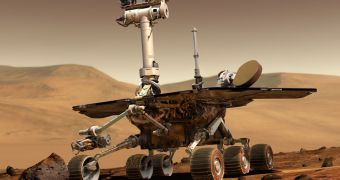The team of experts managing the twin Martian rovers Spirit and Opportunity announce that the MER mission has become the first at NASA to use cloud computing for planning out daily mission operations.
Both rovers will have more flexibility in their mission thanks to on-demand access to cloud computing. Cost will also not be an issue, because the team will only have to pay for the time it actually spends on the cloud.
Most of the software and data that mission controllers at the NASA Jet Propulsion Laboratory (JPL) use for everyday planning of mission activities and drives are now moved to the cloud, experts say.
At this point, Opportunity is the only rover whose activities will be planned using this capability, given that the other Martian robotic explorer, Spirit, is still in hibernation mode for the winter.
JPL scientists expect the rover to make a full recovery any day now, as temperatures continue to rise at its location, and as the Sun spends more and more hours above the horizon near Home Plate.
The rover has been trapped in a patch of loose soil called Troy since May 2009. Attempts of driving it out of the sand have been fruitless, and so now Spirit is officially designated as a stationary science platform.
“This is a change to thinking about computer capacity and data storage as a commodity like electricity, or even the money in your bank account,” explains JPL MER project manager John Callas.
“You don't keep all your money in your wallet. Instead you go to a nearby ATM and get cash when you need it. Your money is safe, and the bank can hold as much or as little of the money as you want,” he adds.
“Data is the same way: You don't need to have it on you all the time. It can be safely stored elsewhere and you can get it anytime via an Internet connection,” the JPL official goes on to say.
Using the clouds is also a lot more practical, especially in terms of cost. With a standard mainframe, the Lab would have had to pay hard cash to install additional servers and processing power.
By using the cloud, all these issues are circumvented, and the JPL team can have access to nearly limitless amounts of processing power and storage room, at a convenient price.
“When we need more computing capacity, we don't need to install more servers if we can rent more capacity from the cloud for just the time we need it,” Callas says.
“This way we don't waste electricity and air conditioning with servers idling waiting to be used, and we don't have to worry about hardware maintenance and operating system obsolescence,” he adds.
Both Spirit and Opportunity have been on Mars since 2004. They were originally scheduled to spend only 3 months roving the planet, but they have now exceeded six years of operations each.

 14 DAY TRIAL //
14 DAY TRIAL //